
Every Spanish-speaking country has its own unique way of speaking the Spanish language. Here are some tips on how to speak Spanish like a Spaniard.
1. Use the vosotros form
If you studied Spanish in school, you have probably at least heard of the vosotros form. However, most teachers brush over it and never really teach it since it is not used in most Spanish-speaking countries. While that may be true, it’s extremely common in Spain so using it and understanding it is essential if you want to blend in with the Spaniards.
Vosotros is an informal plural of “you.” Ustedes is also a plural of “you,” but it can be considered more formal. So, in Spain, if you are speaking to a group of friends you will want to use the Vosotros form. Here’s a quick reference guide:
2. Use vosotros commands
The vosotros form also has its own commands, broken into two sections: affirmative commands and negative commands. Luckily, the affirmative are ridiculously easy to learn. All you have to do is to replace the R with a D on the verb infinitive, and you’re done.
Examples:
Hablar – Hablad
Comer – Comed
Vivir – Vivid
Negative commands require these conjugations:
Hablar – No habléis
Comer – No comáis
Escribir – No escribáis
The only exception is for reflexive verbs (those ending in -se), for example, irse, comerse, pararse, etc.
For affirmative reflexive commands simply drop the R and add -OS to the end of the word:
Levantarse – Levantaos
Sorprenderse – Sorprendeos
Vestirse – Vestíos (IR verbs require an accent mark over the I)
And for the negative commands for reflexive verbs:
Levantarse – No os levantáis
Sorprenderse – No os sorprendáis
Vestirse – No os vestáis
3. Use the “th” sound
Spaniards pronounce certain letters with a “th” sound, which to foreigners may sound something like a lisp, but it is actually just their accent. If a word starts with a C or Z, you’ll pronounce it with a “TH” sound as in the English word think. This is known as the Spanish ceceo. Latin American pronunciation is distinguished by the seseo, or the pronunciation of S, C and Z as S which is different from the ceceo of Spain mentioned above.
Examples:
Cerdo – therdo
Zapatos – thapatos
The “th” sound also comes out when words end in D, like in the command forms I just mentioned.
Examples:
Hablad – Hablath
Sed – seth
4. Use Leísmo
Although leísmo is technically grammatically incorrect, it is widely accepted as part of the Spanish dialect. Leísmo involves using the indirect pronoun “le” or “les” instead of the masculine direct object pronoun “lo” or “los.”
Examples:
Veo el hombre (I see the man) is the basic sentence.
Lo veo is the sentence using a direct pronoun in standard Spanish.
Le veo would be the typical sentence from a Spaniard, using the indirect pronoun le.
It is important to note that the noun being replaced must be a person, not an object, for the rule bending of leísmo to apply.
Can you share any of your experiences with Spanish from Spain? How is it different from other versions of Spanish you have heard?
Check out these other Spain Spanish Slang Expressions articles.
Featured photo credit: sermarr erGuiri via photo pin cc
